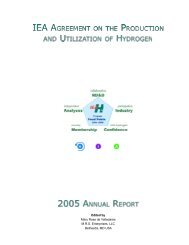Technology Status of Hydrogen Road Vehicles
Technology Status of Hydrogen Road Vehicles
Technology Status of Hydrogen Road Vehicles
You also want an ePaper? Increase the reach of your titles
YUMPU automatically turns print PDFs into web optimized ePapers that Google loves.
! The minimum ignition energy is indeed lower for hydrogen by an order <strong>of</strong> magnitude, but any real-life<br />
ignition source (electrostatic discharge, etc.) has an energy content higher than the minimum for the other<br />
fuels, so again fires can start just as easily with the other fuels.<br />
! Although the detonation limits and velocity are in general higher for hydrogen, the explosive energy <strong>of</strong><br />
the much less dense hydrogen in air is considerably less.<br />
Rather than continue this comparison <strong>of</strong> basic properties, it is much more instructive to proceed by illustrating<br />
hydrogen experience from more traditional industries, analyzing recent integral safety testing for hydrogen<br />
vehicles, and reviewing the findings from the investigation <strong>of</strong> the Challenger accident.<br />
A1.2 <strong>Hydrogen</strong> Safety Experience from Traditional Industries<br />
The most comprehensive treatment available to us 7 on this subject is the Safety Guide for <strong>Hydrogen</strong> published<br />
by the National Research Council Canada (Kalyanam and Moore 1987). It is required reading and reference<br />
for anyone in the field. The main chapters are highlighted here.<br />
A1.2.1 Classifying <strong>Hydrogen</strong> Hazards<br />
The known hazards associated with hydrogen can be classified under the following headings:<br />
! Leakage and spillage<br />
! Combustion<br />
! Detonation<br />
! Reactions with oxidants, halogens, and metals<br />
! Metal embrittlement<br />
! Asphyxiation<br />
! Cryogenic hazards<br />
A1.2.2 Methods for Reducing Risks<br />
The general industrial practices and guidelines for reducing risks in hydrogen systems are:<br />
! Comply with codes, standards, and guidelines.<br />
! Limit quantities for indoor storage.<br />
! Locate and separate process and storage equipment.<br />
! Control hydrogen accumulation within enclosures.<br />
! Exclude air.<br />
! Eliminate ignition sources.<br />
! Detect and control leakage.<br />
! Contain LH 2 spills.<br />
! Verify instrumentation.<br />
! Verify safety reliefs.<br />
! Vent and dispose safely.<br />
! Select proper construction materials.<br />
7 As already mentioned, the unpublished report EQHHPP Nov. 1993 would supersede this since<br />
it is in effect an updating <strong>of</strong> the available safety information and methodology, and includes a valuable survey <strong>of</strong><br />
the international regulations, as well as the national ones <strong>of</strong> 6 countries <strong>of</strong> Europe and North America; it also<br />
addresses the societal concerns regarding hydrogen safety.<br />
27













